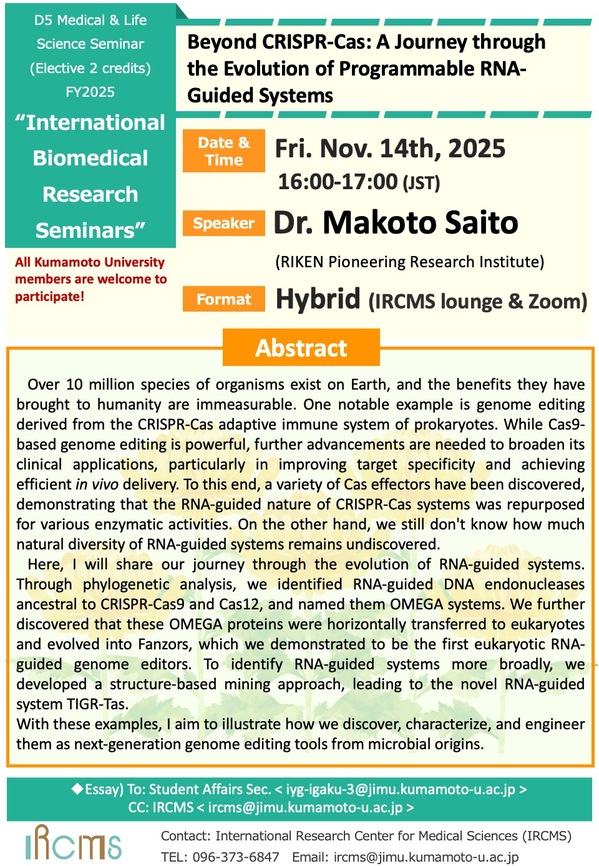- HOME
- News & Events
- [Nov. 14] D5 Seminar - Dr. Makoto Saito (RIKEN Pioneering Research Institute)
News & Events
[Nov. 14] D5 Seminar - Dr. Makoto Saito (RIKEN Pioneering Research Institute)
October 27 2025
The "D5 Medical & Life Science Seminar" course will be offered by International Research Center for Medical Sciences (IRCMS). It will run from May 2025 to March 2026, with lectures given by scientists who are affiliated with IRCMS or in collaboration with researchers at IRCMS. The lectures will be given once a month, in English, and by leading scientists in the relevant research field. Students will be taught: 1) how normal physiological functions are maintained in the human body; 2) how these systems become abnormal under certain pathophysiologic conditions; 3) why stem cells are important in animal development and homeostasis; 4) how stem cell-based approaches can help us understand disease mechanisms and find potential cure for diseases related to stem cell malfunction (e.g., cancer, aging).
Anyone who wants to join is welcome.
For students who have registered for the course, please check your attendance in Moodle.
Date : November 14th, 2025 (Friday)
Format : Hybrid (IRCMS lounge and zoom)
Time : 16:00 - 17:00 (JST)
Speaker : Dr. Makoto Saito (RIKEN Pioneering Research Institute)
Title : Beyond CRISPR-Cas: A Journey through the Evolution of Programmable RNA-Guided Systems
Abstract :
Over 10 million species of organisms exist on Earth, and the benefits they have brought to humanity are immeasurable. One notable example is genome editing derived from the CRISPR-Cas adaptive immune system of prokaryotes. While Cas9-based genome editing is powerful, further advancements are needed to broaden its clinical applications, particularly in improving target specificity and achieving efficient in vivo delivery. To this end, a variety of Cas effectors have been discovered, demonstrating that the RNA-guided nature of CRISPR-Cas systems was repurposed for various enzymatic activities. On the other hand, we still don't know how much natural diversity of RNA-guided systems remains undiscovered.
Here, I will share our journey through the evolution of RNA-guided systems. Through phylogenetic analysis, we identified RNA-guided DNA endonucleases ancestral to CRISPR-Cas9 and Cas12, and named them OMEGA systems. We further discovered that these OMEGA proteins were horizontally transferred to eukaryotes and evolved into Fanzors, which we demonstrated to be the first eukaryotic RNA-guided genome editors. To identify RNA-guided systems more broadly, we developed a structure-based mining approach, leading to the novel RNA-guided system TIGR-Tas.
With these examples, I aim to illustrate how we discover, characterize, and engineer them as next-generation genome editing tools from microbial origins.
Major Papers:
- Faure, G.*, Saito, M.*, Wilkinson, M. E.*, Quinones-Olvera, N., Xu, P., Flam-Shepherd, D., Kim, S., Reddy, N., Zhu, S., Evgeniou, L., Koonin, E. V., Macrae, R. K. and Zhang, F. (*equal contribution) TIGR-Tas: A family of modular RNA-guided DNA-targeting systems in prokaryotes and their viruses. Science,388, eadv9789, 2025.
- Saito, M.*, Xu, P.*, Faure, G., Maguire, S., Kannan, S., Altae-Tran, H., Vo, S., Desimone, A., Macrae, R. K. and Zhang, F. (*equal contribution) Fanzor is a eukaryotic programmable RNA-guided endonuclease. Nature, 620, 660-668, 2023.
- Saito, M.*, Ladha, A.*, Strecker, J.*, Faure, G.*, Neumann, E., Altae-Tran, H., Macrae, R. K. and Zhang, F. (*equal contribution) Dual modes of CRISPR-associated transposon homing. Cell, 184, 2441-2453, 2021.
Flyer: (Click to enlarge)

